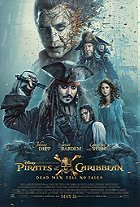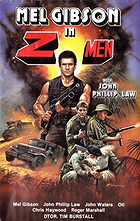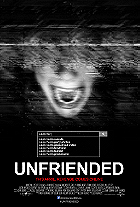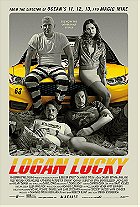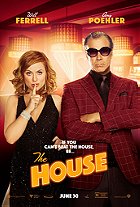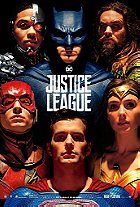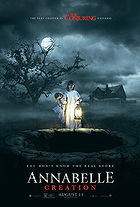Despite its critical and commercial success, certain vocal armchair critics felt that 2015's Star Wars: Episode VII - The Force Awakens played things too "safe," and merely rehashed 1977's Star Wars. Answering that criticism is writer-director Rian Johnson's Star Wars: Episode VIII - The Last Jedi, which takes this new trilogy in fresh and bold directions, defying the smug expectations of those who assumed they were just in for a remake of The Empire Strikes Back. In addition, whereas The Force Awakens was a fast-paced, escapist blockbuster, Johnson slams on the brakes to deal with story development and drama, opting for epic storytelling over constant thrills, and requiring patience. Indeed, The Force Awakens was more purely enjoyable, but this follow-up is the superior movie. Exquisitely polished, appropriately rousing and emotionally rich, The Last Jedi is another stalwart Star Wars adventure that proves that there is still plenty of life left in this long-running film series.
The location of the Resistance base has been exposed, prompting General Leia Organa (Carrie Fisher) to evacuate as the First Order closes in under the leadership of Supreme Leader Snoke (Andy Serkis). But the Resistance fleet cannot escape the First Order and are critically short on fuel, not to mention their starfighter fleet has been obliterated. Unsure of their leadership, Finn (John Boyega) and ace pilot Poe Dameron (Oscar Isaac) go rogue in an attempt to save what's left of the dwindling Resistance forces. To this end, Finn teams up with maintenance worker Rose (Kelly Marie Tran) to disable the tracking system of the First Order's main Star Destroyer. Meanwhile, Rey (Daisy Ridley) and Chewbacca have tracked down Jedi Master Luke Skywalker (Mark Hamill) who now lives like a hermit on the isolated planet of Ahch-To, the location of the First Jedi Temple. Rey begs Luke to leave his self-imposed exile and join the fight against the First Order, but he's haunted by his past failures. Even though Luke reluctantly agrees to teach Rey the ways of the Jedi, he fears that she will be seduced by the Dark Side, much like his nephew Kylo Ren/Ben Solo (Adam Driver).
Picking up immediately after The Force Awakens, the narrative of The Last Jedi is unexpected, and its ultimate trajectory and plot surprises cannot be spoiled. Happily, aside from sharing a few tiny surface details, this is truly the furthest thing possible from a remake of The Empire Strikes Back. (It's satisfying to see how confidently Johnson shuts down those who have spent the last two years arrogantly assuming they have "figured out" this new trilogy.) Johnson's vision is dark, and he unearths astonishing depth and thematic density to create a more adult motion picture, which is a welcome surprise given that this is a Disney production. Whereas George Lucas built the original Star Wars trilogy around concepts such as Joseph Campbell's hero's journey, Luke is now fully aware that happy endings never last, and that becoming a legend is not necessarily a good thing. The characters here debate the merits of holding onto the past, not to mention the Jedi religion and its hubris are brutally deconstructed. One of the movie's most powerful scenes involves the surprise return of an old character, who has much wisdom to impart. Other themes also crop up throughout The Last Jedi, including the business of war, as arms dealers sell to both sides of the conflict to earn their riches. The self-reflection is certainly welcome for a franchise that has just celebrated its 40th anniversary.
The Last Jedi is certainly long, clocking in at 150 minutes which is the most substantial runtime of the saga to date, and it does feel its length. This particular story doesn't exactly lend itself to a tidy three-act structure, and therefore what amounts to Act 2 feels incredibly beefy and is a bit too overcomplicated for its own good. Johnson also has a proclivity for defying expectations to surprise the audience, often stubbornly refusing to let the heroes win, but he pulls these types of tricks a bit too much, sacrificing a degree of narrative stability in the process. Working in the picture's favour, however, is a pronounced sense of humour amid the armrest-clenching action sequences, suffusing the material with some much-needed humanity and levity. There is even a dialogue exchange in the opening minutes of the film, played for laughs, that's unlike anything we have previously witnessed in the franchise's history. Plus, in the casino on Canto Bight, a drunk space-leprechaun mistakes BB-8 for a slot machine. For all of the hoo-ha about the Porgs - small seabird-esque creatures that inhabit the planet of Ahch-To - their presence is insignificant, and they don't immediately irritate in the same way as the Ewoks from 1983's Return of the Jedi.
In terms of tone, The Last Jedi is closer to something like Christopher Nolan's Dunkirk, and in many ways feels more like a proper war film than 2016's Rogue One. There are certain chaotic sequences in which the Resistance frantically scramble to survive, with a pervading sense of utter hopelessness, that we simply don't see in major motion pictures very often. When Johnson does cut loose to deliver the type of thrilling action that Star Wars fans yearn for, he does not disappoint. Lightsaber skirmishes visibly take influence from samurai pictures, while large-scale battles evoke classic war movies. The jaw-dropping extended conflict to close out the second act would be an exceptional climax in any other movie, but Johnson has even more up his sleeve for the actual climax, which packs a real punch. Furthermore, Crait's distinctive red and white landscape makes the finale's striking visuals look like something from an art-house film. This is Johnson's biggest movie to date in terms of scope and budget, but it appears that his previous directorial endeavours properly prepared him for the world of Star Wars.
For a movie of such a large budget (and considering that it spent the best part of 18 months in post-production), it's disheartening that some of the digital effects are sloppy (particularly the crystal critters on Crait and the space horse stampede on Canto Bight), and a certain returning character in a surprise cameo looks slightly off. Outside of these slight imperfections, however, The Last Jedi is visually stunning, with rock-solid photography courtesy of Johnson's regular cinematographer Steve Yedlin (Brick, Looper), who predominantly captured the action with a combination of 35mm and 65mm film stock to generate an aesthetic reminiscent of the original trilogy. It looks as if practical model ships were photographed as opposed to wall-to-wall CGI, as the realism and immediacy of the outer space battles is magnificent. It's also a joy to behold real sets and locations. Meanwhile, the motion capture techniques used to bring Snoke to life are better than ever, looking astonishingly intricate and tangible. Perfectly complementing the visuals is the score by series veteran John Williams. His reliably majestic compositions actually have more presence than The Force Awakens, and recognisable beats from the original trilogy are incorporated during certain moments. Williams' work is simply invaluable.
Nobody back in 1977 could have predicted that Hamill would be capable of such a performance here, as he disappears into the role and submits the best acting work of his career. It's a treat to see Hamill taking a bigger role this time around, while Fisher is likewise a more significant presence, which is a huge deal since this is the last time we will see Princess Leia. (Outside of the odd occasional Rogue One moment, if any of the spinoffs go that way.) Fisher endows her performance with authority, gravitas, wisdom and warmth, and seeing her play this iconic character just once more is both poignant and bittersweet. Fisher's daughter Billie Lourd is also given a beefier role as an officer in the Resistance, and she's a delight, not to mention it's wonderful to see her acting alongside her mother. Out of the newcomers, Laura Dern is a notably brilliant addition as Vice Admiral Holdo, and Benicio Del Toro carves out a particularly memorable character. Meanwhile, after making such a positive impression in The Force Awakens, Ridley continues to impress and is given the chance to really flex her acting muscles and show us what she's made of. It's an extraordinary performance, and of course, she maintains her innate charisma throughout, making her easy to latch onto. Driver also has the chance to find more depth, and he's consistently excellent, portraying a layered, conflicted antagonist. Isaac shines yet again in his role as Poe (his dress now looking a bit similar to Han Solo), showing the same type of spunk and boyish charm exhibited by Harrison Ford in the original Star Wars trilogy. Unfortunately, Tran is less successful as Rose - she lacks spark and charisma. At least Boyega places forth another terrific performance, proving yet again that he was an ideal pick for the role of Finn. Long-time fans should be wary that outside of Luke and Leia, the veteran characters do not have a great deal to do - in particular, R2-D2 is barely glimpsed.
Spoiler Discussion: One point of contention with The Last Jedi involves the death of Luke Skywalker, who projects an avatar of himself across the galaxy to confront Kylo Ren on Crait. Admittedly, it is disappointing that Luke never engages in combat during this new trilogy, with Johnson denying a satisfying, action-laden payoff to the ostensible build-up throughout The Force Awakens and The Last Jedi. However, Luke's sacrifice is the purest Jedi act in the saga so far, reflecting their central philosophy of peace; after all, Yoda taught Luke "A Jedi uses the Force for knowledge and defence, never for attack." After years on Ahch-To, hiding in shame, Luke redeems his failures by sacrificing himself, in the process distracting the First Order for long enough for the Resistance to escape. It’s a fitting end for Luke's arc, with the Jedi Master fading from physical existence as he overlooks a sun-drenched horizon, evoking the image of the Tatooine sunset in 1977's Star Wars. It's also a more rewarding and significant ending than a fan service moment comprising Luke actually facing down the First Order with a lightsaber, a situation that he jokes about earlier in the film. As for Luke's controversial attempted murder of his nephew, Luke has always been impulsive; he is never in full control of his feelings or impulses. Just as he needed a contemplative moment to decide to spare Darth Vader in Return of the Jedi, Luke's recklessness led him to ignite his lightsaber over Ben, but a second of contemplation prevented him from committing the attempted murder. Again, this bold material is challenging in a saga typically characterised by colourful action. Arguably, if The Force Awakens and The Last Jedi were actually Episodes 10 and 11, which followed a trilogy comparable to Timothy Zahn's Thrawn trilogy - beset with action, fan service, and lots of Han, Luke and Leia - these new movies would be better-received. But with the old characters returning for the first time in over thirty years, we wanted to see them in action together once more. End Spoilers.
More than just a brainless fireworks reel, Star Wars: The Last Jedi emerges as one of the year's most intelligent and compelling blockbusters, with Johnson extracting superlative performances across the board and pushing the boundaries of the Star Wars franchise. It’s a compelling and often entertaining feature, the best in the franchise since The Empire Strikes Back. Of course, it does refuse to provide answers to all the burning questions that you may have (particularly in regards to the origins of Snoke, and Rey's lineage), and there are imperfections, but The Last Jedi gets far more right than wrong, setting the stage for what has the potential to be one hell of a closing chapter. Johnson also eschews pure fan service as he finds his bold new vision, and as a result, your mileage with the finished movie may vary depending on your willingness to watch it with an open mind. It is worth noting that, like its immediate predecessor, The Last Jedi not only stands up to repeat viewings but actually improves a second time around.
More than just a brainless fireworks reel, Star Wars: The Last Jedi emerges as one of the year's most intelligent and compelling blockbusters, with Johnson extracting superlative performances across the board and pushing the boundaries of the Star Wars franchise. It’s a compelling and often entertaining feature, the best in the franchise since The Empire Strikes Back. Of course, it does refuse to provide answers to all the burning questions that you may have (particularly in regards to the origins of Snoke, and Rey's lineage), and there are imperfections, but The Last Jedi gets far more right than wrong, setting the stage for what has the potential to be one hell of a closing chapter. Johnson also eschews pure fan service as he finds his bold new vision, and as a result, your mileage with the finished movie may vary depending on your willingness to watch it with an open mind. It is worth noting that, like its immediate predecessor, The Last Jedi not only stands up to repeat viewings but actually improves a second time around.
8.3/10
 Login
Login
 Home
Home 183 Lists
183 Lists 1668 Reviews
1668 Reviews Collections
Collections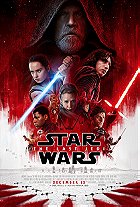




 0 comments,
0 comments, 